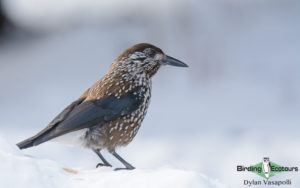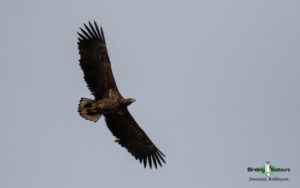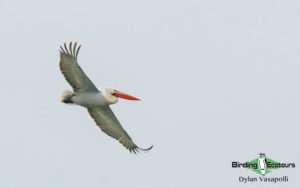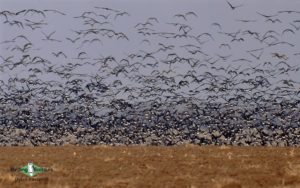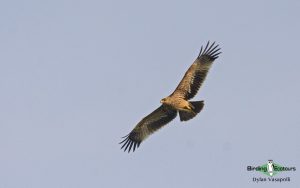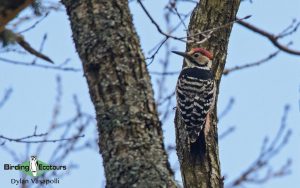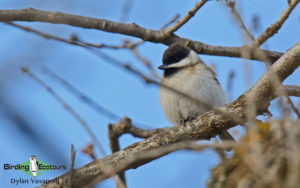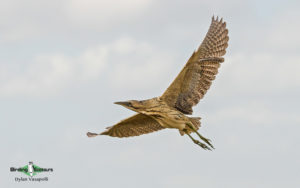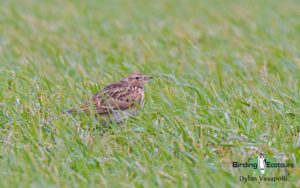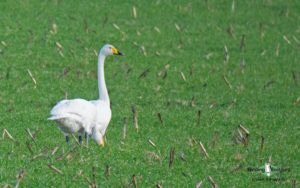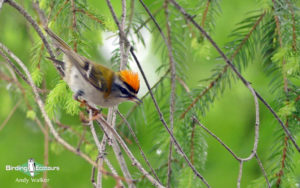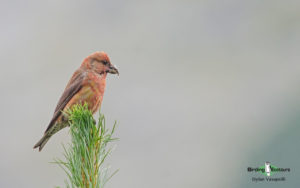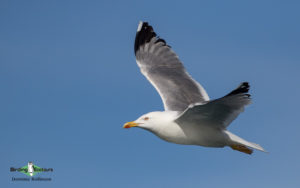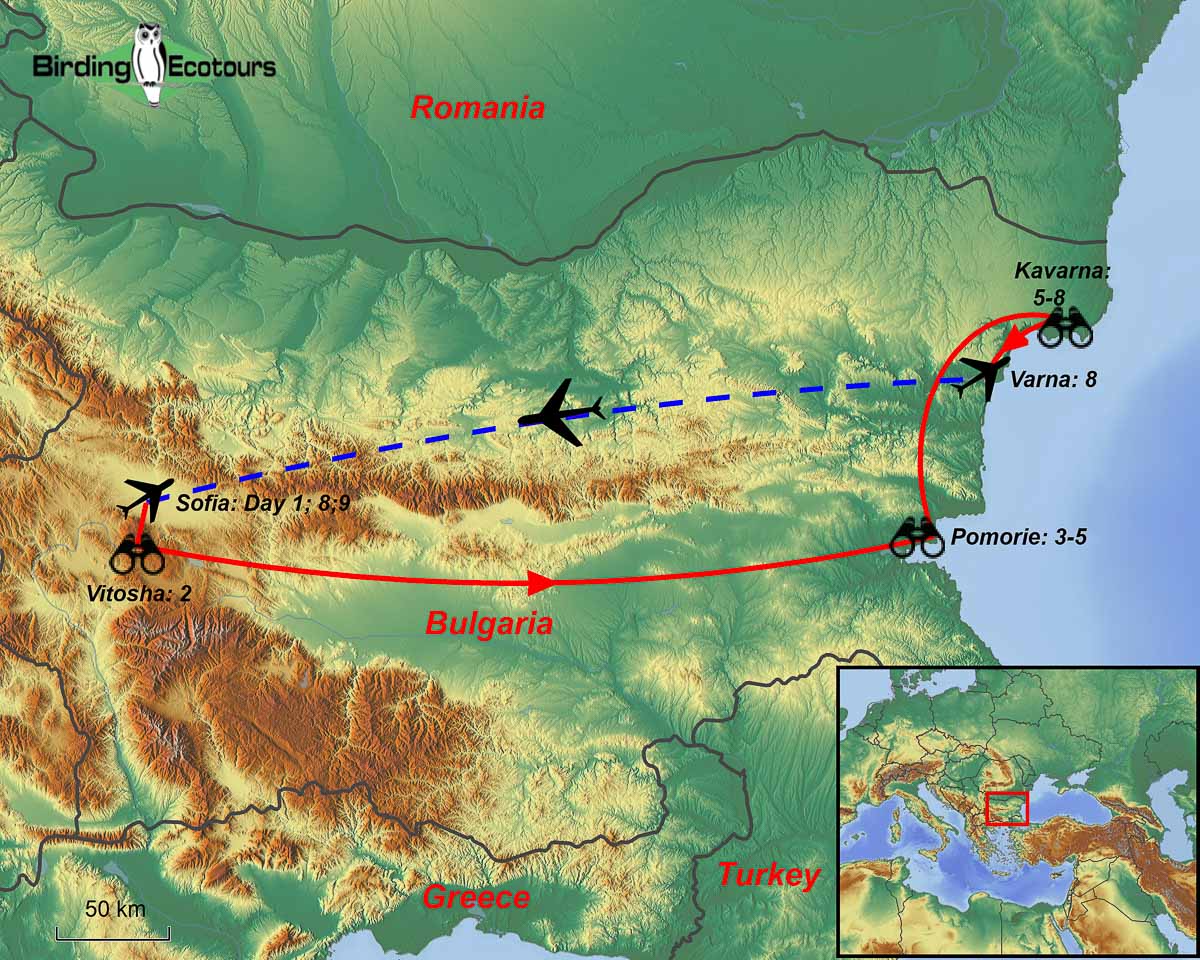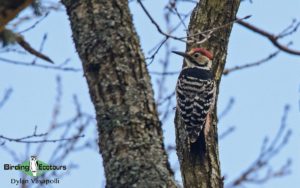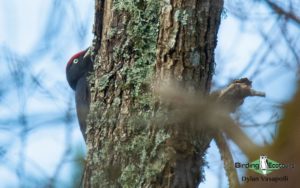Bulgaria: Birding the Black Sea and Vitosha in Winter
Go to: Bulgaria Birding Tours | Birding Tours in Europe | All our birding tours
Bulgaria Birding Tour: Birding the Black Sea and Vitosha in Winter
February 2026
Bulgaria’s position in southeast Europe results in a range of species that are not found further west on the continent. During winter, the country holds vast numbers of geese and other waterfowl that make use of this small area in Eastern Europe, and results in fantastic birding opportunities.
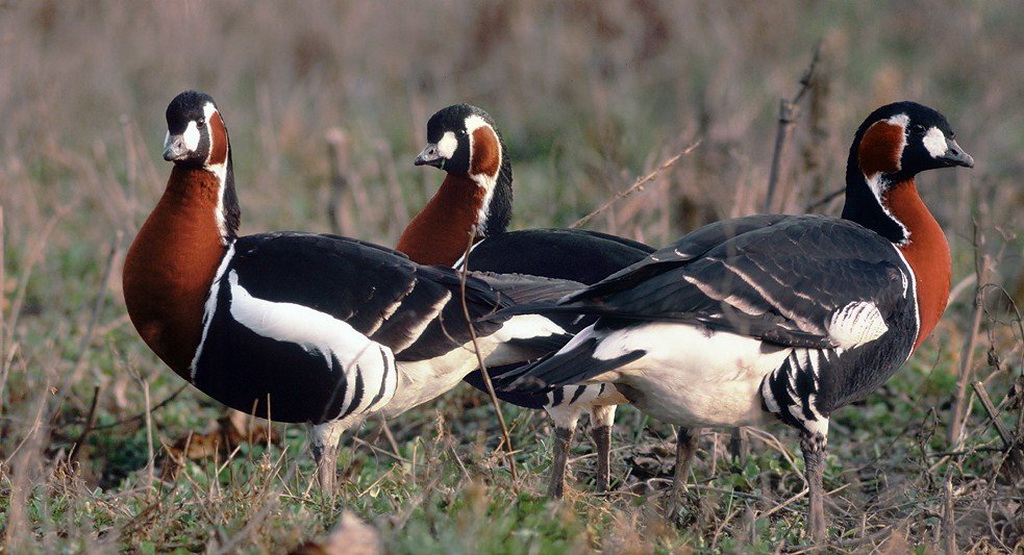 The striking Red-breasted Goose is a special of the Kavarna area.
The striking Red-breasted Goose is a special of the Kavarna area.
This birding tour encompasses the best of Bulgarian, and indeed Eastern European, birding during the winter months and commences in the capital city of Sofia. The first birding of our tour will be in the nearby and beautiful Vitosha Mountain National Park, where we can search for forest specials like Spotted Nutcracker, Black Woodpecker, Eurasian Goshawk, Firecrest, Red (Common) Crossbill, and a wide range of common European woodland birds like Eurasian Blue Tit, Goldcrest, and Willow Tit.
We will then make the journey across Bulgaria from Sofia to Pomorie, on the Black Sea coast. Along the route we will make stops to look for birds like Golden Eagle and Sombre Tit.
While in the Pomorie area we will visit the nearby salt works. The standout species here are the Near Threatened (BirdLife International) Dalmatian Pelican and White-headed Duck which is an Endangered species (BirdLife International). The salt works support many other birds, including various species of shorebirds (waders) and wintering passerines. We will visit some of the region’s protected wetland sites and coastal areas while here. This area holds more interesting species with Pallas’s Gull, Whooper Swan, Tundra (Bewick’s) Swan, and White-tailed Eagle all possible here. While in the area, we will also visit the Strandzha Mountains on the Turkish border, which is home to the exceedingly rare (in Bulgaria) White-backed Woodpecker.
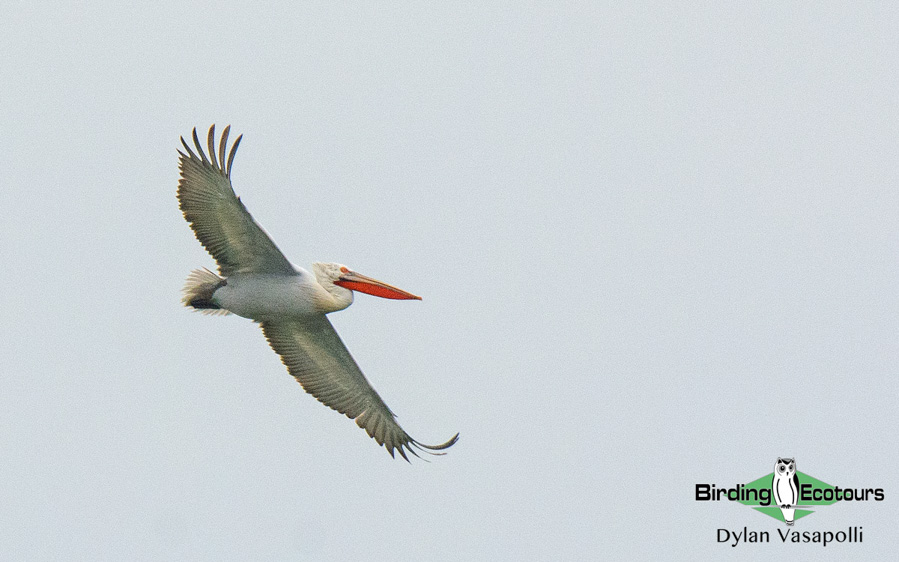
After birding around Pomorie, we will travel north along the coast to the town of Kavana. On the journey we will cross the Balkan mountain range and visit the Baltata National Reserve. This beautiful area is home to the striking Grey-headed Woodpecker and giant Black Woodpecker, while additional roadside stops in vast oak forests along this route may yield more woodpecker sightings, plus Short-toed Treecreeper.
Once in the Kavarna area we will search for the beautiful, yet classified as Vulnerable (BirdLife International), Red-breasted Goose among the tens of thousands of more common Greater White-fronted Goose. We will also visit the picturesque Kaliakra Nature Reserve and nearby Bolata Valley. This is part of Bulgaria’s last remaining steppe habitat and is another key area for wintering geese, including the prized, Red-breasted Goose. We should also come across a variety of wintering passerines, and perhaps the stunning Short-eared Owl. Huge cliffs here are home to the massive Eurasian Eagle-Owl.
The final area we will visit in this part of the country is the vast Durankulak Lake. This is a vitally important migration stopover point but is also very productive in winter. It is here that we will observe the greatest concentrations of geese so far, and hopefully add the Vulnerable (BirdLife International) Lesser White-fronted Goose to our list. This area is also good for birds of prey like Long-legged Buzzard and Rough-legged Buzzard. Sadly, this will bring our tour to an end and we will fly from Varna to Sofia and have one final birding session in Sofia ahead of our flights home.
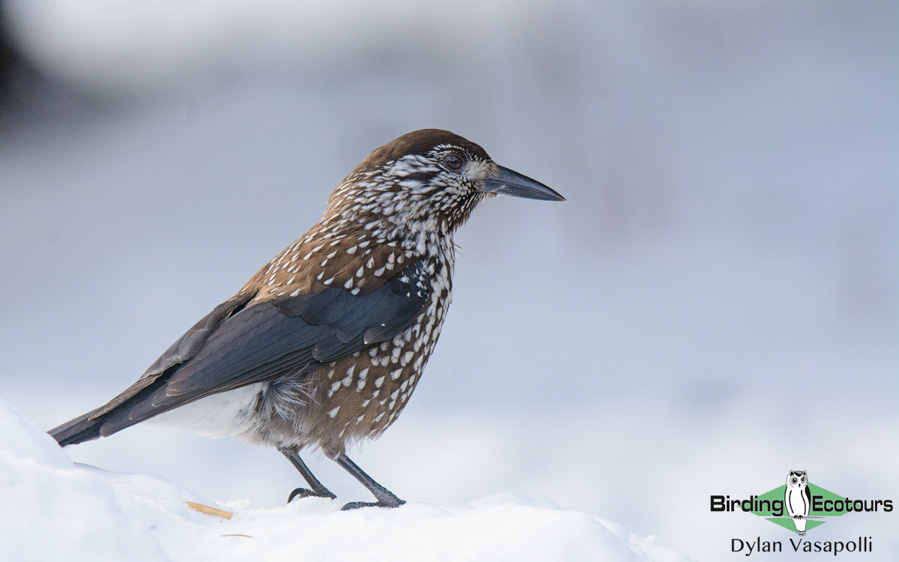
If you would like to extend your time in Eastern Europe, you could join our exciting Birding Tour Azerbaijan: The Enchanting East tour which runs immediately before this one. This stunning country, on the edge of the Western Palearctic, holds a huge range of interesting European and Asian birds. Highlights of our Azerbaijan tour include Marbled Duck, Ferruginous Duck, Grey-headed Swamphen, White-tailed Lapwing, Black Francolin, Little Bustard, Eastern Imperial Eagle, Red-fronted Serin, Moustached Warbler, and White-winged Lark.
Itinerary (9 days/8 nights)
Day 1. Arrival in Sofia, birding Vitosha National Park
After your morning arrival in Sofia, we will transfer the short distance to our hotel, where we check in, relax, and enjoy a group “welcome lunch”. We will spend the afternoon exploring the foothills of Vitosha Mountain National Park. Pine-clad slopes adorn this large massif, and the specials here include Spotted Nutcracker, Red (Common) Crossbill, Common Firecrest, Goldcrest, Marsh Tit, Willow Tit, Rock Dove (real ones!), Eurasian Goshawk, and various woodpeckers, including Great Spotted Woodpecker and Black Woodpecker.
If you are unable to arrive in Sofia in the morning, please arrive the night before the tour, we will happily help book extra accommodation in the city for you.
Overnight: Vitosha Витоша, near Sofia
Day 2. Vitosha National Park, then travel Sofia to Pomorie
We will likely have an early morning walk in Vitosha National Pak again, as we are staying right on the doorstep, and will look for the birds listed above, and others. Following that, we will then travel from Sofia to Pomorie on the southern Black Sea coast of Bulgaria. During the journey we will stop en route for some interesting species, possibly including Golden Eagle, Black Woodpecker, and Sombre Tit. On arrival in the Pomorie area, in the afternoon, we will check into our base for the next three nights and get our birding in the local area underway, providing time is available.
Overnight: Pomorie Поморие
Day 3. Birding Pomorie area
After breakfast at the hotel our birding will begin at the nearby salt works, Atanasovsko. Year-round, dozens of rare and interesting species of birds can be seen here and it is sure to be no different during our tour; a thoroughly exciting day is in the offing.
Species of greater interest during the winter season are the Near Threatened (BirdLife International) Dalmatian Pelican and the Endangered (BirdLife International) White-headed Duck. Other waterfowl found here include Smew, Northern Pintail, Common Pochard, Gadwall, Black-necked Grebe, Greater Flamingo, Pygmy Cormorant, Eurasian Spoonbill, Eurasian Bittern, and Great Egret.
Large numbers of shorebirds (waders), of a wide range of species, can also be expected, such as Pied Avocet, Black-tailed Godwit, Eurasian Curlew, Common Greenshank, and Dunlin while passerines like Water Pipit, Eurasian Penduline Tit, Common Reed Bunting, and Cetti’s Warbler are also found here.
We will also visit the freshwater Lake Burgas. This is yet another superb location for wintering geese and the many thousands of Greater White-fronted Goose should be dotted with smaller numbers of Red-breasted Goose. Ducks and swans are also found here with good numbers of Common Pochard, Mallard, Common Shelduck, Tufted Duck, and Northern Shoveler too.
The amount of prey here makes it an excellent site for wintering birds of prey. During our visit we will keep an eye out for Hen Harrier, Common Buzzard, Common Kestrel, Long-Legged Buzzard, plus the incredibly rare Eastern Imperial Eagle. The lake is also another excellent place to find Dalmatian Pelican.
Like other lakes in the region, the margins are made up of reedbed, woodland, and open field habitats. Highlight birds found around Lake Burgas include Grey Partridge, Syrian Woodpecker, Crested Lark, Common Kingfisher, Grey-headed Woodpecker, Sombre Tit, Calandra Lark, Eurasian Nuthatch, Hawfinch, and Cirl Bunting.
Overnight: Pomorie Поморие
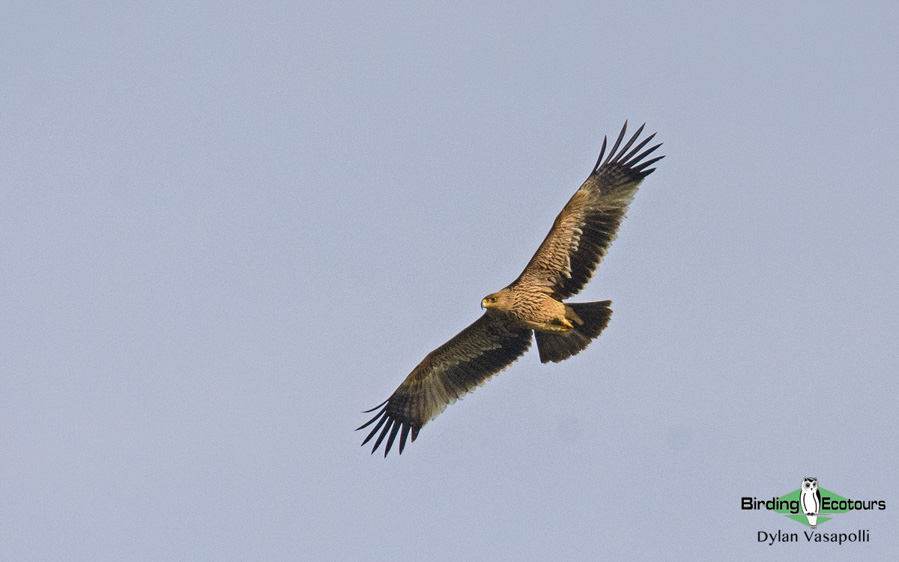
Day 4. Pomorie and Burgas
After breakfast we will continue our observations in the Burgas region. We will visit the protected areas of Lake Mandra, Bay of Chengene Skele, and Foros Bay, which are inhabited by a number of locally and globally endangered species. During this day we expect to see a similar suite of species as on Day 3, together with potential specials like Pallas’s Gull, Whooper Swan, Tundra (Bewick’s) Swan, and White-tailed Eagle.
We will also visit the Strandzha Mountains on the Turkish border where Eurasian Blue Tit, Great Tit, Great Spotted Woodpecker, Eurasian Nuthatch, Short-toed Treecreeper, and Marsh Tit are all common species. The large Black Woodpecker is also found here but can be surprisingly elusive, given its massive size. We will also target White-backed Woodpecker, but these can prove difficult to find, and Middle Spotted Woodpecker which is more common. Other birds we can expect to find here include Eurasian Sparrowhawk, Northern Raven, Eurasian Jay, Mistle Thrush, and Hawfinch. These all amount to a fantastic set of top European woodland birds.
Overnight: Pomorie Поморие
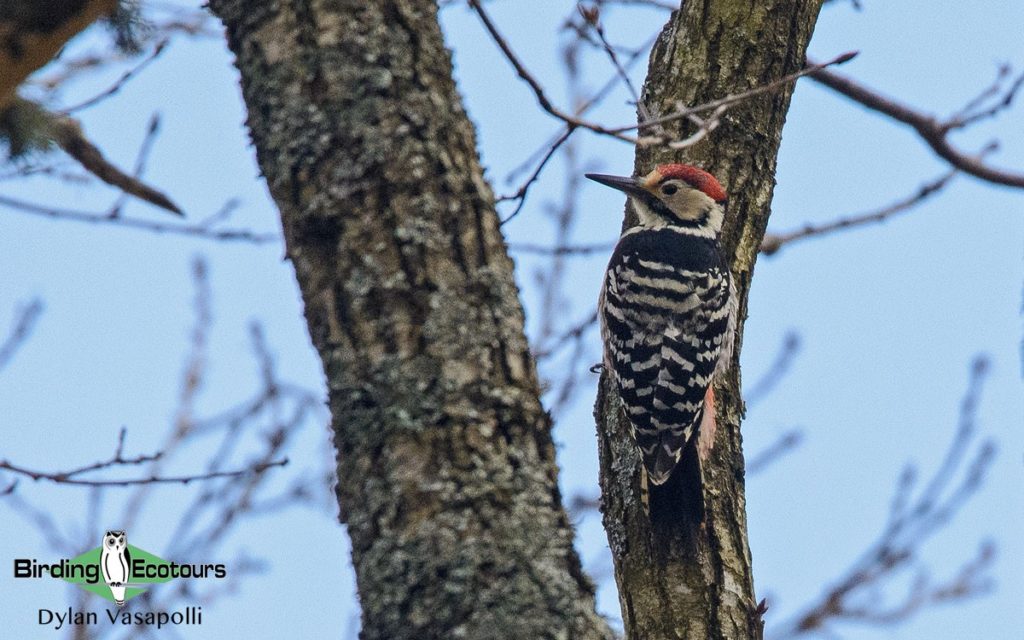
Day 5. Pomorie to Kavarna
Today we transfer from Pomorie to the northern Black Sea coast and the town of Kavarna. We will cross the Stara Planina (Balkan) mountain range, which sweeps down and touches the sea in this part of its lengthy range. We will make several stops on the way where we might find Cirl Bunting, Corn Bunting, Brambling, Sombre Tit, and Woodlark.
We will likely stop for our lunch break at a local restaurant in the village of Goritsa. The forested hills here are cloaked in beautiful oak forests. Interesting woodland birds around here include Great Spotted Woodpecker, Middle Spotted Woodpecker, Lesser Spotted Woodpecker, and European Green Woodpecker, plus Short-toed Treecreeper. The final short stop for the day, before arriving at our comfortable guesthouse in Kavarna for the next three nights, will likely be at the coastal forests of the Baltata National Reserve near Albena. Here we will search for Grey-headed Woodpecker and Black Woodpecker, depending on our sightings over the previous few days.
Overnight: Guest House Nash Dom, Kavarna Каварна
Day 6. Birding around Kavarna
We will have the full day available to explore this northeastern region of Bulgaria, which is the main wintering grounds for the sought-after, rather attractive, and Vulnerable (BirdLife International) Red-breasted Goose. These geese typically make use of the various agricultural fields in the local area where they roost and feed together with large numbers of Greater White-fronted Goose.
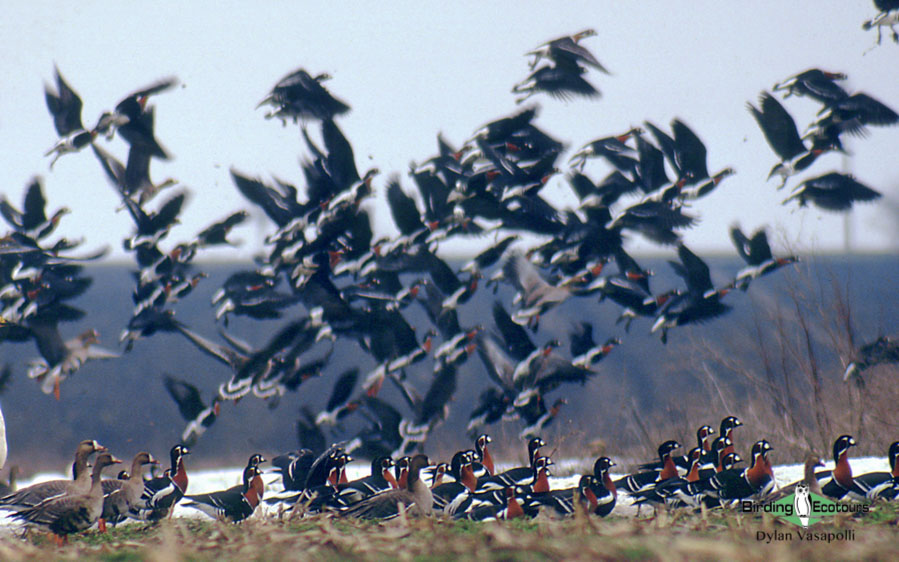
We will concentrate on geese and waterfowl today as we get acquainted with the area. The scenery from the hotel is spectacular, with its glittering blue sea and the nearby rolling hills and valleys. Numerous flocks of geese can often be seen to fly or circle over the hotel as well, giving many opportunities to see these great target birds.
Overnight: Guest House Nash Dom, Kavarna Каварна
Day 7. Kavarna and Kaliakra
After breakfast we will visit the Kaliakra Nature Reserve together with the Bolata Valley and the village of Kamen Bryag. The main habitat around here is steppes, or grassy plains, interspersed with scrub and small stunted trees and is also traversed by surprisingly deep valleys. The coast is rocky, with impressive vertical cliffs of over 330 feet (100 meters) falling away into the clear depth of the Black Sea.
Here we will have more opportunities to observe Red-breasted Goose among the vast flocks of Greater White-fronted Goose. We should also see a range of common species, such as Eurasian Wren, Dunnock, Great Crested Grebe, Black-headed Gull, European Shag, Great Cormorant, Great Tit, Common Kestrel, Common Buzzard, Fieldfare, and Corn Bunting.
We will also search for interesting birds that winter in the area including Short-eared Owl, Calandra Lark, Crested Lark, Black-throated Loon (Diver), Yelkouan Shearwater, Water Pipit, Pygmy Cormorant, Hen Harrier, Rough-legged Buzzard, and Black Redstart. After lunch we will make our final visit of the day to the Topola cliffs, where we hope to see Eurasian Eagle-Owl.
Overnight: Guest House Nash Dom, Kavarna Каварна
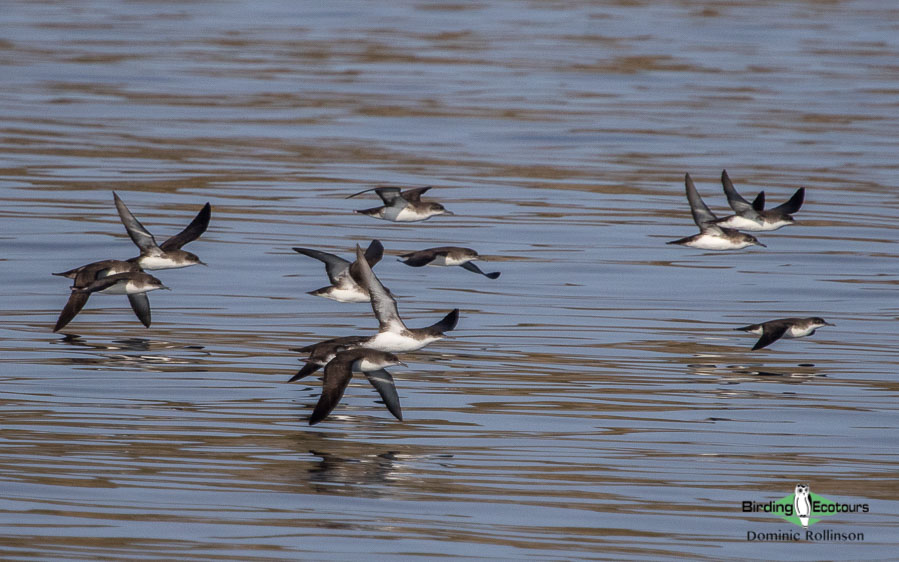
Day 8. Durankulak Lake and surroundings, evening flight Varna to Sofia
A trip to Durankulak Lake and its surrounding areas will take up the majority of our day. A large sandy beach separates the lake from the sea. The area is vitally important in winter with over 130 species regularly recorded here during the season. Here we will observe the greatest concentrations of Red-breasted Goose and Greater White-fronted Goose in Europe. The lake is also an excellent place to find Vulnerable (BirdLife International) Lesser White-fronted Goose. Other wintering waterfowl in the area include Greylag Goose, Mute Swan, Tundra (Bewick’s) Swan, Whooper Swan, Common Pochard, Tufted Duck, Red-breasted Merganser, Ruddy Shelduck, Gadwall, Eurasian Wigeon, Red-crested Pochard, Greater Scaup, Common Goldeneye, and one of the best-looking ducks in the world – Smew.
The area is a particularly good location for birds of prey with species such as Long-legged Buzzard, Rough-legged Buzzard, Common Buzzard, White-tailed Eagle, Hen Harrier, Western Marsh Harrier, Eurasian Goshawk, Eurasian Sparrowhawk, and Common Kestrel all found here.
Durankulak is also surrounded by woodlands, arable fields, and reedbeds which are home to several interesting species, including Syrian Woodpecker, Grey-headed Woodpecker, Calandra Lark, Eurasian Penduline Tit, Black Redstart, Brambling, Hawfinch, Eurasian Bittern, Pygmy Cormorant, Water Rail, Water Pipit, Long-eared Owl, Sombre Tit, Great Grey Shrike, and many others.
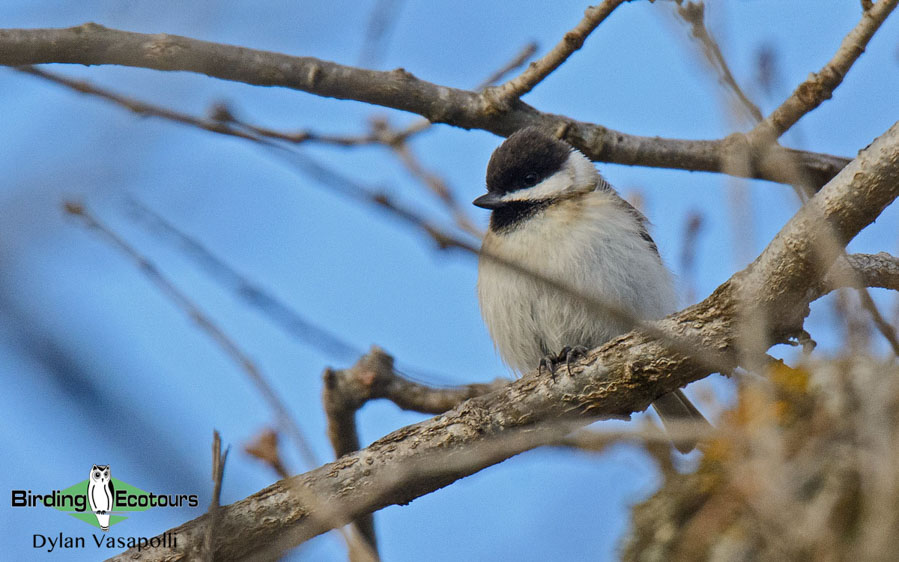
Finally, in recent years the lake has held rare species including Great Bustard, Moustached Warbler, and Pallas’s Gull and so there is always the chance of something unexpected to turn up while we are here, we will keep our eyes peeled!
In the evening we will take a flight from Varna back to Sofia for the last night of the tour, where we will have our final group dinner and choose our ‘bird of the trip’!
Overnight: Sofia
Day 9. Sofia birding, international departure from Sofia
We will have a final morning birding session around Sofia where the city parklands might give us a few final high-quality birds like Eurasian Goshawk, Black Woodpecker, and a range of finches and tits.
Following lunch, we will transfer to Sofia airport, where this short but exciting tour ends, in time for your late afternoon or evening flights out of Bulgaria.
Overnight: Not included
Please note that the itinerary cannot be guaranteed as it is only a rough guide and can be changed (usually slightly) due to factors such as availability of accommodation, updated information on the state of accommodation, roads, weather, or birding sites, the discretion of the guides and other factors. In addition, we sometimes must use a different international guide from the one advertised due to tour scheduling. We plan to take one internal flight on this tour, subject to suitable weather conditions. Please do not book your return flights until late in the afternoon, or in the evening of the final day.
Download ItineraryBulgaria: Birding the Black Sea and Vitosha in Winter Trip Report
4 – 11 FEBRUARY 2019
By Dylan Vasapolli
DOWNLOAD TRIP REPORT
The prized White-backed Woodpecker was one of the major highlights on the tour.
Overview
This Bulgarian winter tour takes in essentially the best of Bulgaria, as we visit the many important bird wintering sites along the Black Sea, along with exploring various woodlands and mountains that play host to some of Europe’s most sought-after species. All these combine for a short, well-rounded tour that is not to be missed.
This particular winter was relatively mild, in comparison to what it usually is, which, although it meant that we didn’t need to brave extremely cold conditions, did also mean that the large numbers of geese which use this region to overwinter didn’t show up to the fullest. And despite the mild winter the weather wasn’t fantastic on the tour; we had to battle cold and windy conditions on most days, which made the birding tough at times. This tour is timed to give us the best chances at the prized Red-breasted Goose, and we were very successful, enjoying sightings on a few occasions, including some great and prolonged looks at a relatively large flock feeding in a wheat field. We still did well on the tour, though, finding many other prized species, including Whooper and Tundra Swans, Ruddy Shelduck, Red-crested Pochard, Ferruginous Duck, Greater Scaup, Smew, White-headed Duck, Black-throated Loon, Eurasian Bittern, Dalmatian Pelican, Golden Eagle, Slender-billed, Pallas’s, and Caspian Gulls, Eurasian Eagle-Owl, a flock of Long-eared Owls, Middle-spotted, Syrian, White-backed, Black, and Grey-headed Woodpeckers, Spotted Nutcracker, Sombre, Marsh, and Willow Tits, Eurasian Penduline Tit, Calandra Lark, Moustached Warbler, Short-toed Treecreeper, White-throated Dipper, and Cirl Bunting among many others.
We finished the tour just shy of 130 species, also noting 3 mammals, with which we were very pleased considering the suboptimal conditions at times.
The localized Sombre Tit was one of the many eastern European specials seen on the tour.
Detailed Report
Day 1, 4th February 2019. Birding around Varna and transfer to Kavarna
Together with Yordan, our local guide, we collected Urban and Nancy from Varna following breakfast, and transferred to the western edge of Lake Varna, where we began our birding. We had a glorious day with bright sunshine, next to no wind, and warm temperatures (with us even reducing our layered clothing to T-shirts during the day!).
The marshes and pools in this area held many waterbirds, despite being close to the industrial zone, and things took off to a good start, with us finding an obliging Cetti’s Warbler that gave us some good views. As we continued working the area we noted two of the scarce Ruddy Shelducks and a small flock of Northern Lapwings that had arrived early along with the sought Pygmy Cormorant, while other species present included Common Shelduck, Common Pochard, Little, Black-necked, and Great Crested Grebes, Grey Heron, Great Cormorant, Western Marsh Harrier, Green Sandpiper, Common Redshank and Black-headed Gull.
The surrounding open plains held numbers of Crested Larks, together with a few White Wagtails, while more numerous species included Common Buzzard, European Goldfinch, Common Kestrel, and Western Jackdaw. A small woodlot gave us the stunning European Green Woodpecker and Hawfinch before we made our way into a small village for lunch. While enjoying our meal we were interrupted by both Syrian and Great Spotted Woodpeckers and Great and European Blue Tits.
Our afternoon was spent birding the Yatata Reserve, where we found many of the waterbirds we had seen earlier in the day, and new additions were Northern Shoveler, Gadwall, an early Eurasian Spoonbill, Great Egret, and Dalmatian Pelican, while Common Kingfisher frustrated us, remaining heard only.
Following our time here we began making our way north to Kavarna and spent the later part of the afternoon into the evening searching for Eurasian Eagle-Owl. We scanned the cliffs for a while, patiently hoping we’d find the bird, and with it getting darker and darker, and just before we were going to call it a day, we heard a few hoots. The call was a bit further up the valley, so we headed slightly further up the road and began scanning. After some time, with almost no light left, we still had had no joy and were about to give up when we spotted the bird perched atop a pine tree. We got it in the scope and enjoyed a great, rather atmospheric sighting of Eurasian Eagle-Owl as it sat atop the tree, calling every so often.
Following this great end to the day we headed to Kavarna and enjoyed an excellent meal before settling in for the evening.
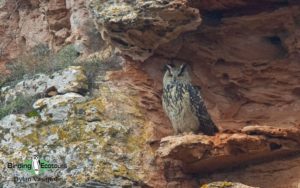
Day 2, 5th February 2019. Birding Durankulak, Shabla, and Bolata
We awoke to a stark contrast in the weather to yesterday, with an icy wind, cold temperatures, thick fog, and some drizzle – rather bleak conditions. Following breakfast we braved the conditions and headed to Durankulak Lake near the Romanian border. The fog seemed to come and go, and we began working the area, but this proved challenging, as the wind kept most of the birds down and at times the fog prevented us from seeing far. A pair of Syrian Woodpeckers showed well in a small woodlot, while the coast was rather quiet, with only gulls moving around every once in a while. Scanning through the gull flocks, however, proved successful, as we found a few of the scarce Pallas’s Gulls, along with some Mew Gulls, among the common Black-headed and Yellow-legged Gulls. While watching a group of gulls flying around we picked something dark going overhead and immediately recognized it as a Red-breasted Goose. We all were able to watch it, as it came around over us, giving us some good, albeit brief flight views, and then lost it as it disappeared out into the fog over the Black Sea. This is one of the most prized species for this region during the winter, and one of the main targets of the trip, so it was a good one to get so early in the trip, considering that this winter hadn’t seen many individuals present in Bulgaria. Other species here during the morning included Eurasian Teal, Common Pochard, Red-breasted Merganser, Western Marsh Harrier, and Common Reed Bunting. We then transferred to a different section of the lake, and some scanning here produced many Tufted Ducks and Common Pochards, while the surrounding fields yielded groups of Grey Partridges and Stock Doves.
Our next stop saw us heading to a small village, where we enjoyed a big Long-eared Owl roost of probably close to 10 individuals – what a privilege! We spent some time watching the birds as they peered down at us through the pine leaves before leaving them in peace.
After warming up over a great lunch we headed into the bleak conditions once more and birded some of the Shabla wetlands. Here we managed to find a small group of Caspian Gulls along with a few ducks including Common Shelduck, Northern Shoveler, and Northern Pintail. A coastal stop gave us a few of the sought European Shags among their similar Great Cormorant cousins. We finally ran into our first flock of Geese, albeit a small one – 14 Greater White-fronted Geese feeding near to the road, and while enjoying them we found a large group of Calandra Larks.
We ended our day in the incredibly scenic Bolata valley, where we managed to enjoy some fine birding despite the wind. Soon after entering we picked up one of the resident Eurasian Eagle-Owls and enjoyed some excellent scope views of the bird, and just as we were loading up, going to try another vantage for the owl, we found a Eurasian Bullfinch that had just flown in and managed to enjoy some good scope views of this tricky bird. We worked our way further along and enjoyed some more fine views of the owl before visiting the beach. Eurasian Jay and Syrian Woodpecker were also seen before we called it a day and headed back to our accommodation.
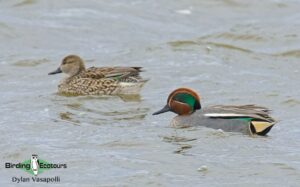
Day 3, 6th February 2019. Birding Durankulak and Kaliakra and surroundings
We had another full day to work the northern Black Sea coast region of Bulgaria and started our day at Durankulak Lake again. Although we didn’t have the dense fog of yesterday we had a much colder day with a stiff wind blowing, which kept most of our stops short. We worked a different area from yesterday, and although it was very quiet in the beginning we soon found a flock of European Greenfinches and a surprise Water Pipit that gave us good scope views as it foraged on the beach. We just caught the tail end of a geese flock as they came in and landed out of sight, and while trying to find a vantage point to see where the birds had settled we noticed a Common Snipe, which gave us some good flight views. We managed to track down the flock of geese and found the majority to be Greater White-fronted Geese, with the remainder being the prized Red-breasted Geese! We enjoyed some good scope view, even though the birds were a bit distant, before trying to get a bit closer. They were on the opposite side of the lake, which meant that we had to backtrack some distance to get to them, and on arriving at the field found only a handful of Greater White-fronted Geese remaining – the rest had apparently taken off. We began working the dam from here, finding a group of the scarce Red-crested Pochards, before we picked up on another distant, small flock of geese flying in. As they got closer they turned out to be Red-breasted Geese, and we had some good flight views as they flew by. We continued to another section of the lake and, after scanning for some time, were rewarded with a small group of Ferruginous Ducks, which showed really well. Just as we had finished with the ducks a glorious White-tailed Eagle flew by and eventually landed in a distant field. Other species present here were Common Pochard, Tufted Duck, Red-breasted Merganser, Pygmy Cormorant, and Western Marsh Harrier.
We then headed to town for lunch, relishing being out of the cold wind for a bit. Following lunch we worked the coastal strip between Kamen Bryag and Cape Kaliakra, finding Hen Harrier, a large flock of Calandra Larks that gave us excellent views, and a flock of Common Linnets. Cape Kaliakra was next and afforded us great views of the surrounding coastline, while a sheltered bay below the cape held a frenzy of feeding birds, the majority of which were Great Cormorants and Yellow-legged Gulls, but also present were many Black-necked Grebes, European Shag, and a few Black-throated Loons, while Peregrine Falcon and Common Kestrel worked the rocky cliffs. We also enjoyed a few Common Bottlenose Dolphins off the coast here. We ended our day in the Bolata valley, but it was a lifeless afternoon, and we retired to our guesthouse for the night.
A Calandra Lark pauses for a few moments.
Day 4, 7th February 2019. Transfer from Kavarna to Pomorie, birding en-route
We awoke to another chilly morning with a strong wind blowing, and, following breakfast, began our journey to Pomorie. Our first stop would be at the Baltata Nature Reserve, although, with the strong wind blowing, we were a bit unsure what the birding would be like. As it turned out, we were well sheltered from the wind and enjoyed some fine birding, picking up a few of the prized Grey-headed Woodpeckers, while the scarce Middle-spotted Woodpecker also showed well, together with its Great Spotted Woodpecker cousin. There were also many Eurasian Nuthatches and Short-toed Treecreepers bounding around the trees, and we enjoyed some good looks at them.
Then we made our way out of the nature reserve and onward to Goritsa via Varna. Close to Goritsa we stopped at a large roadside group of swans, which gave us some good views. They turned out to be mainly Whooper Swans, but we did find at least one Tundra Swan with them, along with a lone Greylag Goose. Some roadside pools held a large flock of Northern Lapwings, a lone Greater White-fronted Goose, a stunning male Hen Harrier, and a surprise Broad-billed Sandpiper, which we observe at some length.
After having our fill here we enjoyed a good lunch in Goritsa before heading into the nearby woodlands. Although the birding was on the quiet side we managed to find European Green Woodpecker, while Great Spotted Woodpecker also showed well, as did a few lively Long-tailed Tits. We then drove onward to our last stop, where we had hoped to track down Sombre Tit, but the wind had picked up, and it was incredibly quiet in the wooded valley we found ourselves in, with sadly only a few Great Tits, Common Blackbirds, and a group of Common Chaffinches being seen.
After cutting our loses here we pressed onward to the coast, but not before stopping in one of the roadside villages, where we finally managed looks at a Little Owl along with Black Redstart, and while doing so a flock of Ruddy Shelducks passed by overhead – a great way to end the day!
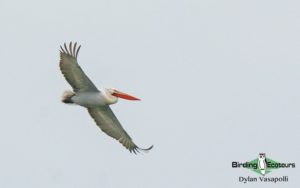
Day 5, 8th February 2019. Birding Pomorie, Burgas and surrounds.
We had an exciting day in store for us, as we’d try and track down the geese flocks that were present in the area. Our day, however, started off at Lake Pomorie, just across from our hotel, where we spent some time working this vast area. Although we had a cold wind blowing right onto us and could only manage a few minutes of looking through the scope before having to take a break as our eyes watered up, we did exceptionally well, with the standouts going to a number of sough-after Smews and a few rare Greater Scaups. We also enjoyed many other species, including Eurasian Wigeon, Common Shelduck, Northern Pintail, Eurasian Teal, Common Pochard, Tufted Duck, and Red-breasted Merganser, while we also managed to find the likes of Sandwich Tern and shorebirds in the form of a few Grey Plovers and Dunlin along with our first Eurasian Sparrowhawk and Water Pipit. After having had enough of the wind in our faces we tried to track down the geese and managed to find the flock without much effort. We were absolutely gobsmacked by the huge numbers of geese present, with the majority going to Greater White-fronted Geese, which numbered between 80,000 and 100,000 individuals, and the flock also held our main target, the spectacular Red-breasted Goose, which numbered between 500 and 1,000 individuals. While we had seen the geese earlier on the trip the views had left us wanting more, and it was great to connect with them again in substantial numbers. We spent some time watching the geese and listening to them chatter before trying to get a bit closer, stalking them through some rank vegetation. We reached our end point, where we enjoyed some truly fantastic views of these birds and were able to just take in the enormous amount of birds present in the field.
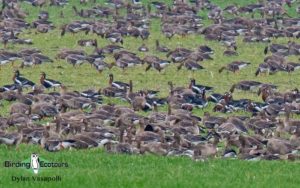
We eventually had to tear ourselves away, as lunch beckoned, and as we were making our way out of the area we picked up many more geese coming in (well into the thousands) and watched as they too joined the ranks of the geese already present in the field. Also present in the flock was a large group of Whooper Swans, but, try as we might, unfortunately we couldn’t pick out any Tundra Swans amongst them.
Following a great celebratory lunch we made our way back to Burgas, birding a few wetland sites. Our main goal was the tricky and localized White-headed Duck, and we struck gold finding a large flock, probably near 100 individuals, that gave us great views. Other birds seen included Gadwall, Dalmatian Pelican, Pygmy Cormorant, and Little and Caspian Gulls among other more widespread waterbirds.
We ended our day at the Burgas salt pans, where we again marveled at the many birds present here. Although the majority were Common Shelduck and Eurasian Teal we were also able to pick out a single Great White Pelican among the many Dalmatian Pelicans, while a scan of the gull roost gave us a few of the smart Slender-billed Gulls and a single Mediterranean Gull, and we were also able to add to our shorebird list, picking up Common Greenshank, Black-tailed Godwit, and Eurasian Curlew. A good bottle of wine rounded off our highly successful day.
Day 6, 9th February 2019. Birding the Strandzha mountain massif and surroundings
We left the hotel early, bound for the Strandzha mountains on the Turkish border, which would be our primary location today. Our first stop was at a small coastal wetland, where we would search for Moustached Warbler. The first bird we saw as we got out of the car was a Eurasian Bittern that we saw flying over the reeds, and as it disappeared we picked up a European Stonechat flitting about, which gave us some good views. Not a bad start to the morning! We soon heard a calling Moustached Warbler and managed to track it down, but the views were brief, as it stuck to thick cover, not coming out into the open. Our perseverance paid off, however, as we all eventually enjoyed great scope views of this tough bird on a few occasions. Some close Crested Larks saw us off as we continued into the hills.
The Strandzha mountains were quiet when we first arrived and only slowly began to liven up as we continued deeper into the area. Eurasian Blue and Great Tits formed the bulk of the birds encountered, but we also found Great Spotted Woodpecker, Eurasian Nuthatch, Short-toed Treecreeper, and a few Marsh Tits. The large Black Woodpecker was our first big target to fall, and we had great, prolonged looks at a male that appeared in answer to our tape – always a privilege seeing this bird!
A curios Black Woodpecker peered at us from behind a trunk.
One of our other main targets, White-backed Woodpecker, proved difficult to find, and only after quite a bit of time walking the trails we eventually heard a drumming bird, which took a bit of time to track down. But we were well rewarded in the end with great looks at this prized species. We were also able to enjoy good comparative looks at the similar Middle-spotted Woodpecker and even had both birds in the same scope view at one time! Other birds seen in the mountains were Eurasian Sparrowhawk, Common Raven, Eurasian Jay, Mistle Thrush, and Hawfinch.
After enjoying a good picnic lunch we began the trip back to Burgas, stopping along the way at the Beglik Tash ruins. While this was primarily a non-birding stop we were fortunate to come across two species here that had been evading us on the trip so far, Sombre Tit and Lesser Spotted Woodpecker, both of which showed incredibly well.
Our last stop for the day was at the Burgas salt pans in the late afternoon, hoping for any new species. Although we didn’t find any new species we still enjoyed repeat views at many of the usual waterbirds as well as a few Eurasian Spoonbills, Black-tailed Godwit, Eurasian Curlew, Dalmatian Pelican, and Slender-billed Gull.
A fine dinner ended another excellent and highly successful day!
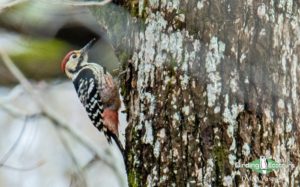
Day 7, 10th February 2019. Transfer from Pomorie to Sofia, birding en route
We once more started the day at Lake Pomorie, near our hotel, where we scanned through the many waterfowl present. We had a very similar suite of species to what we’d had over the last few days, with the standouts being Smew, Common Shelduck, Gadwall, Northern Pintail, Red-breasted Merganser, Greater Scaup, and Water Pipit. However, the biggest surprise was when a small group of Eurasian Penduline Tits came flying in, only to disappear into the reeds. We heard them calling for a while before they took flight once more and disappeared out of sight, leaving us wanting a bit more.
A quick stop at another nearby lake gave us a large flock of the localized White-headed Ducks, but little else, and we soon began the drive to Sofia via the Balkan Mountains. We passed by a number of Greater White-fronted Geese and Whooper Swans close to the road outside of Burgas, but our next main stop came some time further along the lower Balkan slopes, where we were after Golden Eagle. As if right on cue, a stunning adult bird came flying in, giving us a grand show as it was mobbed repeatedly by a Common Buzzard before settling on the top of a pine tree, allowing us to take in every detail of it!
We eventually had to drag ourselves away from this glorious bird, as we progressed to our next stop, which was a pass going over the Balkan Mountains. The upper reaches of the pass were closed due to heavy snowfall, but we birded the slopes up to that point, finding many great species on the route. These included the likes of Mistle Thrush, Willow and Long-tailed Tits, Goldcrest, Red Crossbill, Eurasian Bullfinch, Brambling, and Cirl Bunting.
All too soon our time had run out and we had to press onward to Sofia, where we arrived in the early evening and enjoyed a fantastic final dinner together, reliving the many great moments we had had on the tour!
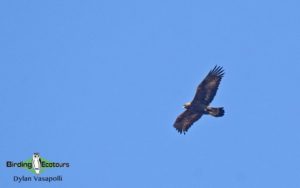
Day 8, 11th February 2019. Birding the Vitosha mountain massif and departure
Our final day had arrived, and we spent the morning on the snow-covered Vitosha mountain, which looms over Sofia. It was quiet on the way up, and on arriving in the upper reaches, where we would focus our birding, we were greeted with a strong wind. This didn’t deter us, though, and we enjoyed some fine birding in some of the sheltered woods. Spotted Nutcracker was first, and these confiding birds gave us excellent, close-up views. Coal Tit proved a bit trickier in the wind, but we eventually all saw a bird, and, as it so often goes, the trees then came alive with Coal Tits, and we couldn’t quite seem to get rid of them! Large flocks of Red Crossbills were also moving around between the pines and gave us good views perched atop the pines.
After spending some time working the area we had to begin making our way back down the mountain, where we searched for White-throated Dipper on the lower reaches. It took some time and scanning, but we eventually encountered a single bird, which, although it proved to be a little erratic, did show well. A good lunch in town brought the tour to an end, and we said goodbye to Urban and Nancy.
I would just like to thank Urban and Nancy for a truly great trip with good fun had, and even better birding, right throughout the trip! We did exceptionally well, finding almost all of the region’s winter specials, along with a host of other prized species, but our time with the immense flock of Greater White-fronted and Red-breasted Geese will surely stick with us for a long time. A close second, however, was the great time had in the Strandzha mountains, enjoying really fine birding with the likes of the highly-prized Black and White-backed Woodpeckers being on top of the list. I look forward to the next one!
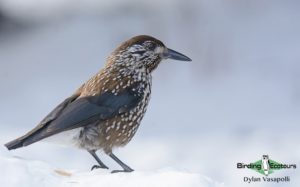
Please see the downloadable PDF above with the full species lists included. This is a sample trip report. Please email us ([email protected]) for more trip reports from this destination.
During our tour, your guide will be driving you in a comfortable vehicle. The tour does not require a great deal of walking or steep hiking to see the bulk of the birds, however a basic level of fitness is required including the ability to occasionally walk over rough terrain.
The weather on the Black Sea coast is likely to be cold during our tour with daytime temperatures ranging from 34 – 55oF (1 – 13oC). Nighttime temperatures are likely to be very cold, ranging from 23 – 41oF (-5 – 5oC). There is a reasonable chance of some rain during our tour and snow is expected at points, especially at the beginning and end of the tour in the Vitosha National Park area.

